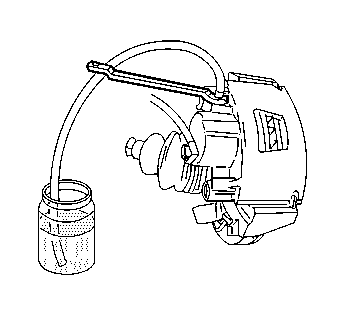
- Deplete the booster reserve
by applying the brakes several times with the engine off until all of the
reserve is depleted.
Do not allow paint to touch painted surfaces.
- Fill the master cylinder reservoir to the full level mark using
only Delco Supreme II Brake fluid or the equivalent, DOT-3 brake fluid, as
specified. Refer to Maintenance and Lubrication in General Information.
| • | Maintain the fluid level in the reservoir during the bleeding. |
| • | Have an assistant press the brake pedal when needed during the
bleeding. |
Important: Be sure the master cylinder reservoir cap is installed before the brake
pedal is pressed . This prevents the brake fluid from spraying from the reservoir.
- If the master cylinder is known or suspected to have air in the bore,
bleed it as follows before bleeding the calipers.
| 3.1. | Loosen the forward brake pipe connection at the master cylinder. |
| 3.2. | Allow the brake fluid to flow from the connector port. |
Maintain the reservoir fluid level.
| 3.3. | Tighten the forward brake pipe on the master cylinder. |
| 3.4. | Depress the brake pedal slowly one time and hold. |
| 3.5. | Loosen the forward brake pipe connection again to purge air from
the bore. |
| 3.6. | Tighten the connection and then slowly release the brake pedal. |
Tighten
Tighten the brake pipe connection to 15 N·m (11 lb ft).
| 3.8. | Repeat the sequence, including the 15 second wait. Repeat until
all of the air is removed from the bore. |
| 3.9. | Repeat this procedure and bleed the master cylinder at the rear
connection. |
- Bleed the individual wheel calipers only after all of the air
is removed from the master cylinder.
If the calipers dot not contain air bleeding is not needed.
- If all of the wheel circuits must be bled use the following sequence:
- Raise the vehicle and suitably support. Refer to
Lifting and Jacking the Vehicle
in General Information.
- Remove the bleeder valve cap and place the proper size box-end
wrench or J 21472
/J 28434
, over the bleeder
valve.
- Attach a transparent tube to the bleeder valve.
- Submerge the other end of the tube in a clear container partially
filled with clean brake fluid.
- Depress the brake pedal slowly one time and hold.
Use slow pedal action. Rapid pedal pumping pushes the master cylinder
secondary piston down the bore in a way that makes bleeding the system difficult.
| 10.1. | Loosen the bleeder valve to purge the air from the caliper. |
| 10.2. | Tighten the bleeder valve. |
Tighten
Tighten the caliper bleeder valve to 13 N·m (115 lb ft).
Notice: Use the correct fastener in the correct location. Replacement fasteners
must be the correct part number for that application. Fasteners requiring
replacement or fasteners requiring the use of thread locking compound or sealant
are identified in the service procedure. Do not use paints, lubricants, or
corrosion inhibitors on fasteners or fastener joint surfaces unless specified.
These coatings affect fastener torque and joint clamping force and may damage
the fastener. Use the correct tightening sequence and specifications when
installing fasteners in order to avoid damage to parts and systems.
| 10.3. | Slowly release the brake pedal. |
| 10.4. | Wait fifteen seconds. |
| 10.5. | Repeat the sequence, including the 15 second wait, until all of
the air is removed. |
The sequence may need to be bled ten times or more to remove all of
the air.
- Install the bleeder valve caps.
- Lower the vehicle. Refer to
Lifting and Jacking the Vehicle
in General Information.
- Fill the master cylinder to the full mark.
- Check the brake pedal for sponginess.
- Repeat the entire bleeding procedure to correct the sponginess
if found.
- Pressure bleed the brake system using scan tool, after the manual
bleeding procedure is complete.

